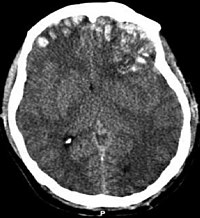
Photo from wikipedia
BACKGROUND Brain injury guidelines (BIG) were developed to reduce overutilization of neurosurgical consultation (NC) as well as computed tomography (CT) imaging. Currently, BIG have been successfully applied to adult populations,… Click to show full abstract
BACKGROUND Brain injury guidelines (BIG) were developed to reduce overutilization of neurosurgical consultation (NC) as well as computed tomography (CT) imaging. Currently, BIG have been successfully applied to adult populations, but the value of implementing these guidelines among pediatric patients remains unassessed. Therefore, the aim of this study was to evaluate the established BIG (BIG-1 category) for managing pediatric traumatic brain injury (TBI) patients with intracranial hemorrhage (ICH) without NC (no-NC). METHODS We prospectively implemented the BIG-1 category (normal neurologic examination, ICH ⩽ 4 mm limited to one location, no skull fracture) to identify pediatric TBI patients (age, ⩽ 21 years) that were to be managed no-NC. Propensity score matching was performed to match these no-NC patients to a similar cohort of patients managed with NC before the implementation of BIG in a 1:1 ratio for demographics, severity of injury, and type as well as size of ICH. Our primary outcome measure was need for neurosurgical intervention. RESULTS A total of 405 pediatric TBI patients were enrolled, of which 160 (NC, 80; no-NC, 80) were propensity score matched. The mean age was 9.03 ± 7.47 years, 62.1% (n = 85) were male, the median Glasgow Coma Scale score was 15 (13–15), and the median head Abbreviated Injury Scale score was 2 (2–3). A subanalysis based on stratifying patients by age groups showed a decreased in the use of repeat head CT (p = 0.02) in the no-NC group, with no difference in progression (p = 0.34) and the need for neurosurgical intervention (p = 0.9) compared with the NC group. CONCLUSION The BIG can be safely and effectively implemented in pediatric TBI patients. Reducing repeat head CT in pediatric patients has long-term sequelae. Likewise, adhering to the guidelines helps in reducing radiation exposure across all age groups. LEVEL OF EVIDENCE Therapeutic/care management, level III.
Journal Title: Journal of Trauma and Acute Care Surgery
Year Published: 2017
Link to full text (if available)
Share on Social Media: Sign Up to like & get
recommendations!